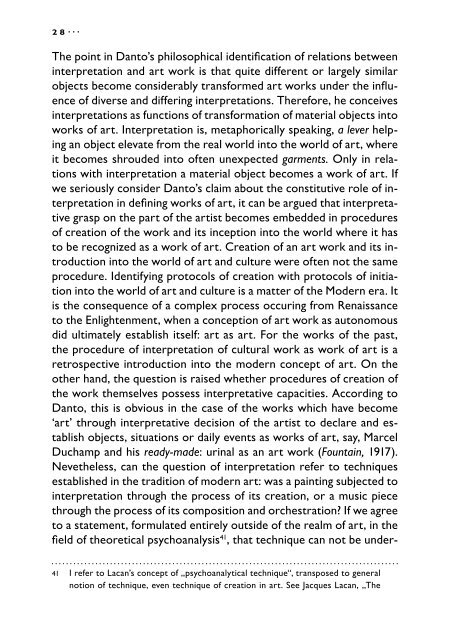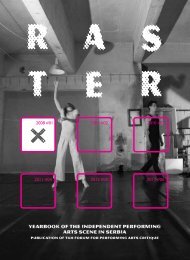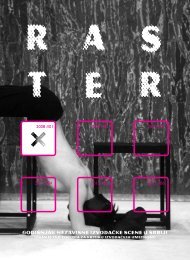Miško Šuvaković Epistemology of Art - TkH
Miško Šuvaković Epistemology of Art - TkH
Miško Šuvaković Epistemology of Art - TkH
Create successful ePaper yourself
Turn your PDF publications into a flip-book with our unique Google optimized e-Paper software.
28··· ··· 29<br />
The point in Danto’s philosophical identification <strong>of</strong> relations between<br />
interpretation and art work is that quite different or largely similar<br />
objects become considerably transformed art works under the influence<br />
<strong>of</strong> diverse and differing interpretations. Therefore, he conceives<br />
interpretations as functions <strong>of</strong> transformation <strong>of</strong> material objects into<br />
works <strong>of</strong> art. Interpretation is, metaphorically speaking, a lever helping<br />
an object elevate from the real world into the world <strong>of</strong> art, where<br />
it becomes shrouded into <strong>of</strong>ten unexpected garments. Only in relations<br />
with interpretation a material object becomes a work <strong>of</strong> art. If<br />
we seriously consider Danto’s claim about the constitutive role <strong>of</strong> interpretation<br />
in defining works <strong>of</strong> art, it can be argued that interpretative<br />
grasp on the part <strong>of</strong> the artist becomes embedded in procedures<br />
<strong>of</strong> creation <strong>of</strong> the work and its inception into the world where it has<br />
to be recognized as a work <strong>of</strong> art. Creation <strong>of</strong> an art work and its introduction<br />
into the world <strong>of</strong> art and culture were <strong>of</strong>ten not the same<br />
procedure. Identifying protocols <strong>of</strong> creation with protocols <strong>of</strong> initiation<br />
into the world <strong>of</strong> art and culture is a matter <strong>of</strong> the Modern era. It<br />
is the consequence <strong>of</strong> a complex process occuring from Renaissance<br />
to the Enlightenment, when a conception <strong>of</strong> art work as autonomous<br />
did ultimately establish itself: art as art. For the works <strong>of</strong> the past,<br />
the procedure <strong>of</strong> interpretation <strong>of</strong> cultural work as work <strong>of</strong> art is a<br />
retrospective introduction into the modern concept <strong>of</strong> art. On the<br />
other hand, the question is raised whether procedures <strong>of</strong> creation <strong>of</strong><br />
the work themselves possess interpretative capacities. According to<br />
Danto, this is obvious in the case <strong>of</strong> the works which have become<br />
‘art’ through interpretative decision <strong>of</strong> the artist to declare and establish<br />
objects, situations or daily events as works <strong>of</strong> art, say, Marcel<br />
Duchamp and his ready-made: urinal as an art work (Fountain, 1917).<br />
Nevetheless, can the question <strong>of</strong> interpretation refer to techniques<br />
established in the tradition <strong>of</strong> modern art: was a painting subjected to<br />
interpretation through the process <strong>of</strong> its creation, or a music piece<br />
through the process <strong>of</strong> its composition and orchestration? If we agree<br />
to a statement, formulated entirely outside <strong>of</strong> the realm <strong>of</strong> art, in the<br />
field <strong>of</strong> theoretical psychoanalysis 41 , that technique can not be under-<br />
41 I refer to Lacan’s concept <strong>of</strong> „psychoanalytical technique“, transposed to general<br />
notion <strong>of</strong> technique, even technique <strong>of</strong> creation in art. See Jacques Lacan, „The<br />
stood, and thus cannot be properly applied if we do not apprehend<br />
its underlying concepts, it can be assumed that every creation, i.e. application<br />
<strong>of</strong> certain artistic techniques, is an interpretation detectable<br />
in the work itself or in the complex relations between the work and<br />
discourses <strong>of</strong> the culture pertaining to it and making it viable and acceptable<br />
as a work <strong>of</strong> art. Accordingly, a protocol can be formulated,<br />
defining poetic as immanent in relation to creation and existence <strong>of</strong><br />
an art work. Poetics is not identified as philosophy, particular humanity<br />
or theory on modes <strong>of</strong> existence <strong>of</strong> an art work, but as a discursive<br />
network connecting or fostering idiosyncratic and open relations<br />
between the author, the work, and the world <strong>of</strong> art. Such poetics<br />
need not be ‘verbalized’: nevertheless it needs to be demonstrated<br />
and made public by way <strong>of</strong> a protocol. Ultimately, it needs to be reduced<br />
to a ‘concept’. A concept refers to a depictable abstraction <strong>of</strong><br />
an art work. The poetic manifests by way <strong>of</strong> the work itself, or in the<br />
relations between the work and critical interpretations empowering<br />
it to exist as a work <strong>of</strong> art in a world <strong>of</strong> art. Translation <strong>of</strong> the<br />
‘poetic’ surrounding the art work into a verbal discourse <strong>of</strong> exterior<br />
poetics, humanities or art theory, is an auxiliary operation wherein<br />
means <strong>of</strong> creation and existence <strong>of</strong> an art work in the world <strong>of</strong> art, in<br />
culture and society, are plainly revealed. The modernistic composer<br />
Igor Stravinsky defined Poetics 42 as a retrospective conceptualization<br />
and verbalization, i.e. metaphorization, <strong>of</strong> idiosyncratic protocols in<br />
creating a piece. His poetics is auto-poetics. Auto-poetics implies<br />
protocols and procedures <strong>of</strong> auto-reflexive analyses and debates, deployed<br />
by the artist and pertaining to his artistic output – formulated<br />
either as personal accounts (correspondence, diaries, interviews),<br />
proclamations (manifests, statements), pedagogic colloquia (teaching<br />
developed by the artist from his own production, treatises and<br />
practicums), essays (proto-literary personal or speculative reflections<br />
on matters <strong>of</strong> art) or theoretical writings (meta-lingual analyses and<br />
discussions <strong>of</strong> the concepts, nature and the world <strong>of</strong> art). Stravinsky<br />
defines his auto-poetics, contrary to the pro-scientific poetics <strong>of</strong> Ar-<br />
Function and Field <strong>of</strong> Speech and Language“, from Ecrits: The First Complete Edition<br />
in English, W.W. Norton, 2007, p. 247.<br />
42 Igor Stravinsky, „Poetics <strong>of</strong> Music (1939-40)“, from Edward A. Lippman (ed), Musical<br />
Aesthetics: A Historical Reader – Vol. III – The Twentieth Century, Pendragon Press,<br />
Stuyvesant, New York, 1986, pp. 153-166.







